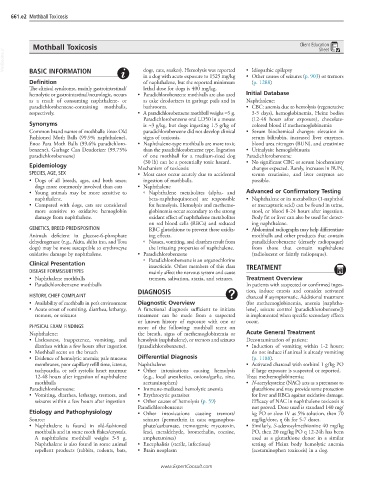Page 1311 - Cote clinical veterinary advisor dogs and cats 4th
P. 1311
661.e2 Mothball Toxicosis
Mothball Toxicosis Client Education
Sheet
VetBooks.ir
dogs, cats, snakes). Hemolysis was reported
BASIC INFORMATION
• Other causes of seizures (p. 903) or tremors
in a dog with acute exposure to 1525 mg/kg • Idiopathic epilepsy
Definition of naphthalene, but the reported minimum (p. 1288)
The clinical syndrome, mainly gastrointestinal/ lethal dose for dogs is 400 mg/kg.
hemolytic or gastrointestinal/neurologic, occurs • Paradichlorobenzene mothballs are also used Initial Database
as a result of consuming naphthalene- or as cake deodorizers in garbage pails and in Naphthalene:
paradichlorobenzene-containing mothballs, bathrooms. • CBC: anemia due to hemolysis (regenerative
respectively. • A paradichlorobenzene mothball weighs ≈5 g. 3-5 days), hemoglobinemia, Heinz bodies
Paradichlorobenzene oral LD50 in a mouse (12-48 hours after exposure), chocolate-
Synonyms is ≈3 g/kg, but dogs ingesting 1.5 g/kg of colored blood if methemoglobinemia
Common brand names of mothballs: Enoz Old paradichlorobenzene did not develop clinical • Serum biochemical changes: elevation in
Fashioned Moth Balls (99.9% naphthalene), signs of toxicosis. serum bilirubin, increased liver enzymes,
Enoz Para Moth Balls (99.6% paradichloro- • Naphthalene-type mothballs are more toxic blood urea nitrogen (BUN), and creatinine
benzene), Garbage Can Deodorizer (99.75% than the paradichlorobenzene type. Ingestion • Urinalysis: hemoglobinuria
paradichlorobenzene) of one mothball for a medium-sized dog Paradichlorobenzene:
(30 lb) can be a potentially toxic hazard. • No significant CBC or serum biochemistry
Epidemiology Mechanism of toxicosis: changes expected. Rarely, increases in BUN,
SPECIES, AGE, SEX • Most cases occur acutely due to accidental serum creatinine, and liver enzymes are
• Dogs of all breeds, ages, and both sexes; ingestion of mothballs. possible.
dogs more commonly involved than cats • Naphthalene
• Young animals may be more sensitive to ○ Naphthalene metabolites (alpha- and Advanced or Confirmatory Testing
naphthalene. beta-naphthoquinones) are responsible • Naphthalene or its metabolites (1-naphthol
• Compared with dogs, cats are considered for hemolysis. Hemolysis and methemo- or mercapturic acid) can be found in urine,
more sensitive to oxidative hemoglobin globinemia occur secondary to the strong stool, or blood 8-24 hours after ingestion.
damage from naphthalene. oxidant effect of naphthalene metabolites Body fat or liver can also be used for detect-
on red blood cells (RBCs) and reduced ing naphthalene.
GENETICS, BREED PREDISPOSITION RBC glutathione to prevent these oxidiz- • Abdominal radiographs may help differentiate
Animals deficient in glucose-6-phosphate ing effects. mothballs and other products that contain
dehydrogenase (e.g., Akita, shiba inu, and Tosa ○ Nausea, vomiting, and diarrhea result from paradichlorobenzene (densely radiopaque)
dogs) may be more susceptible to erythrocyte the irritating properties of naphthalene. from those that contain naphthalene
oxidative damage by naphthalene. • Paradichlorobenzene (radiolucent or faintly radiopaque).
○ Paradichlorobenzene is an organochlorine
Clinical Presentation insecticide. Other members of this class
DISEASE FORMS/SUBTYPES mainly affect the nervous system and cause TREATMENT
• Naphthalene mothballs tremors, salivation, ataxia, and seizures. Treatment Overview
• Paradichlorobenzene mothballs In patients with suspected or confirmed inges-
DIAGNOSIS tion, induce emesis and consider activated
HISTORY, CHIEF COMPLAINT charcoal if asymptomatic. Additional treatment
• Availability of mothballs in pet’s environment Diagnostic Overview (for methemoglobinemia, anemia [naphtha-
• Acute onset of vomiting, diarrhea, lethargy, A functional diagnosis sufficient to initiate lene], seizure control [paradichlorobenzene])
tremors, or seizures treatment can be made from a suspected is implemented when specific secondary effects
or known history of exposure with one or occur.
PHYSICAL EXAM FINDINGS more of the following: mothball scent on
Naphthalene: the breath, signs of methemoglobinemia or Acute General Treatment
• Listlessness, inappetence, vomiting, and hemolysis (naphthalene), or tremors and seizures Decontamination of patient:
diarrhea within a few hours after ingestion (paradichlorobenzene). • Induction of vomiting within 1-2 hours;
• Mothball scent on the breath do not induce if animal is already vomiting
• Evidence of hemolytic anemia; pale mucous Differential Diagnosis (p. 1188).
membranes, poor capillary refill time, icterus, Naphthalene: • Activated charcoal with sorbitol 1 g/kg PO
tachycardia, or soft systolic heart murmur • Other intoxications causing hemolysis if large exposure is suspected or reported.
12-48 hours after ingestion of naphthalene (e.g., local anesthetics, onions/garlic, zinc, Treat methemoglobinemia:
mothballs acetaminophen) • N-acetylcysteine (NAC) acts as a precursor to
Paradichlorobenzene: • Immune-mediated hemolytic anemia glutathione and may provide some protection
• Vomiting, diarrhea, lethargy, tremors, and • Erythrocytic parasites for liver and RBCs against oxidative damage.
seizures within a few hours after ingestion • Other causes of hemolysis (p. 59) Efficacy of NAC in naphthalene toxicosis is
Paradichlorobenzene: not proved. Dose used is standard 140 mg/
Etiology and Pathophysiology • Other intoxications causing tremors/ kg PO or slow IV as 5% solution, then 70
Source: seizures (permethrin in cats; organophos- mg/kg/dose, q 6h for 5-7 doses.
• Naphthalene is found in old-fashioned phate/carbamate, tremorgenic mycotoxin, • Similarly, S-adenosylmethionine 40 mg/kg
mothballs and in some moth flakes/crystals. lead, metaldehyde, bromethalin, cocaine, PO, then 20 mg/kg PO q 12-24h has been
A naphthalene mothball weighs 3-5 g. amphetamines) used as a glutathione donor in a similar
Naphthalene is also found in some animal • Encephalitis (sterile, infectious) setting of Heinz body hemolytic anemia
repellent products (rabbits, rodents, bats, • Brain neoplasm (acetaminophen toxicosis) in a dog.
www.ExpertConsult.com

